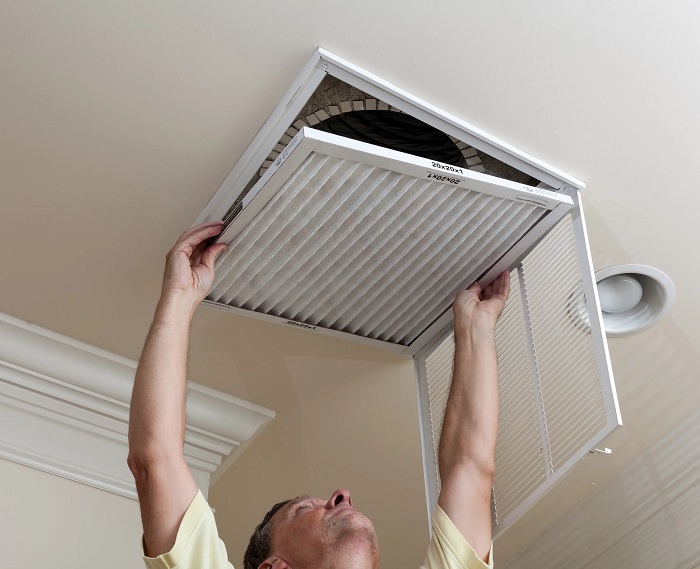The air filter is one of the simplest yet most critical parts of an HVAC system. It traps dust, pollen, and fine debris before air reaches the blower and ducts. When the filter clogs, airflow drops, components overheat, and indoor air quality declines. Replacing it on time keeps the system efficient and extends its lifespan. Below are real maintenance and HVAC repair cases that show how technicians deal with filter-related problems and what happens when this routine task is neglected.
Case 1: Weak Airflow and Uneven Cooling
In one Manhattan apartment, a customer complained that the living room stayed warm while bedrooms cooled normally. The technician removed the return grille and found the air filter completely packed with gray dust. Air could barely pass through. Once replaced, airflow measured at the vent increased by 40%. The cooling difference between rooms disappeared within an hour. A dirty filter often gives the impression of compressor failure, while the real cause is simple air restriction.
Case 2: Frozen Evaporator Coil
Another case involved a system that blew warm air instead of cold. Inside the air handler, the evaporator coil was covered with ice. Low airflow due to a blocked filter had allowed refrigerant temperature to drop below freezing. The technician shut off the system, melted the ice, replaced the clogged filter, and checked refrigerant levels to ensure no further issues. After restarting, the coil stayed dry, and cooling performance returned to normal. This kind of failure shows how a neglected filter can mimic serious mechanical faults.
Case 3: Short Cycling and High Energy Bills
A homeowner noticed that the HVAC unit turned on and off every few minutes. This “short cycling” often happens when the system overheats from restricted airflow. During inspection, the technician found a filter that hadn’t been changed for almost a year. The motor had to work harder, triggering thermal protection repeatedly. After replacing the filter and cleaning dust from the blower wheel, the cycle time normalized. Electricity consumption dropped significantly during the next billing period.
Case 4: Dust Accumulation in Ducts and Registers
In another service visit, technicians were called because rooms became dusty right after cleaning. The problem was traced to a missing filter — someone had removed it months earlier to “improve airflow.” Without a filter, fine dust collected inside the ducts and blew back into the house. The team cleaned the ductwork, installed a new high-efficiency pleated filter, and sealed small air leaks. Within days, the air became noticeably cleaner and easier to breathe. The customer also reported fewer allergy symptoms.
Case 5: Noise from the Return Vent
A less obvious symptom of a clogged filter is whistling or hissing near the return vent. This occurs when the system struggles to draw air through a restricted surface. In one case, the technician measured a pressure drop twice the normal level. Replacing the filter eliminated the sound immediately. When airflow is obstructed, the blower motor compensates by spinning faster, which creates extra strain and unnecessary noise.
Case 6: Furnace Overheating During Winter
Filters affect not only cooling but also heating. During a winter service call, the furnace repeatedly shut down before reaching the target temperature. The technician found a dense layer of soot and debris blocking the filter. Restricted airflow caused the heat exchanger to overheat, triggering the safety switch. After installing a clean filter and verifying proper airflow, the furnace operated smoothly again. The homeowner was advised to replace filters every three months during heavy use.
How Technicians Choose and Replace Filters
Not all filters are equal. During maintenance, technicians typically check three main parameters:
- Size: It must match the frame perfectly to prevent air bypass.
- MERV rating: The higher the number, the finer the filtration. Most homes use MERV 8–11.
- Material: Pleated synthetic filters last longer than thin fiberglass panels.
Replacement itself takes a few minutes — remove the old one, clean the housing, check airflow direction arrows, and insert the new filter firmly. Before finishing, most technicians measure static pressure to ensure the new filter allows proper circulation.
Recommended Replacement Frequency
- Every 1–2 months for standard fiberglass filters.
- Every 3–6 months for pleated high-efficiency filters.
- Every month in homes with pets or smokers.
- More frequently during peak heating or cooling seasons.
Neglecting this schedule causes gradual system stress. Compressors run longer, coils collect dust, and humidity control worsens.
Signs That It’s Time to Change the Filter
- Weak airflow from vents.
- More dust settling on furniture.
- Unusual smell when the HVAC starts.
- Rising energy bills without weather changes.
- Noise near the return grille.
If any of these appear, checking the filter should be the first step before calling for repair.
Filter replacement seems trivial, yet it is the foundation of HVAC reliability. Every technician has seen units fail prematurely because of nothing more than neglected filters. Clean airflow means lower energy costs, stable indoor temperature, and longer life for every component — from blower motors to evaporator coils. Regular replacement keeps the system working efficiently and ensures that every room gets clean, conditioned air without strain or noise.
